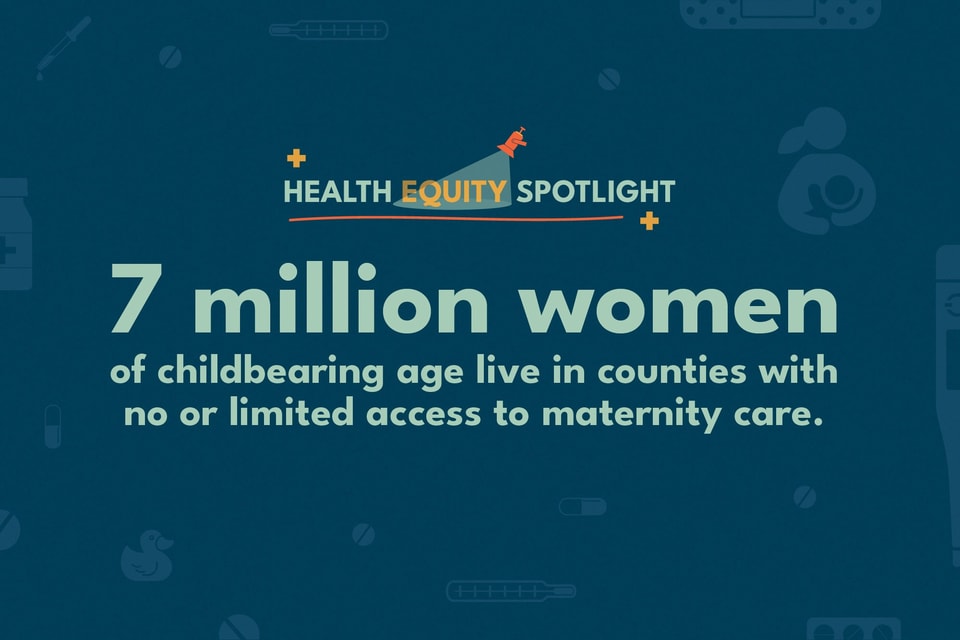Blog Published October 11, 2022 · 6 minute read
What Roe’s Fall Means for America’s Maternity Care Deserts
Kylie Murdock

They say everything is bigger in Texas, but that’s not always a good thing. Texas leads the country in maternity ward closures, putting far too many people in what’s called a maternity care desert. Just take residents in Alpine, close to the west Texas town of Marfa, who have to travel an hour and a half to Big Bend Regional Medical Center. Unless it’s one of the four days it’s not open; then they have to drive another hour to Fort Stockton or give birth in an emergency room, which often lacks the proper equipment or training for births.
But it’s not just Texas. With Roe v. Wade overturned, 26 states have banned abortions or plan to—some more strictly than others. The result? The end of Roe will lead to 159,700 more births each year in the United States according to industry experts. Miscarriages, premature births, and pregnancy complications will also rise. Overall, there will be a higher demand for obstetric services at a time when the United States is already facing a shortage of OB services, and many are living in a maternity care desert. That’s why we must take steps now to bolster the number of obstetricians in this country and start to rescue maternity care deserts.
America’s OB Shortage
As of 2020, 7 million women of childbearing age lived in counties with no or limited access to maternity care. This care includes obstetrician-gynecologist (OBGYN) doctors, which many women use for primary care, hospitals with obstetrics (OB) services, birthing centers, and certified midwives. Maternity care deserts tend to have higher poverty rates and lower median incomes, so most don’t have the resources to travel miles to the closest provider. For pregnant women, this can mean no or late prenatal care, which can have detrimental consequences for the mom and baby down the line. For those giving birth, it could be the difference between life and death.
This shortage is even more pronounced in rural areas. Half of rural counties don’t have hospital obstetric services or a single OBGYN or certified midwife. And it’s only getting worse as these communities continue to lose access to OB services. Between 2014 and 2018, 53 rural counties lost access to obstetrics care. And an April 2022 survey found that a quarter of rural hospitals are currently considering closing their OB wings. Women in rural areas are left having to drive hours to the nearest hospital with OB services. When they have complications or require an emergency delivery, that’s not really an option. And delivering in a hospital without these services greatly increases the chances of infant and/or maternal mortality.
This lack of access is due in part to a shortage of physicians–the American Congress of Obstetricians and Gynecologists estimate a shortage of more than 9,000 OBGYNs. But a driving force is profits, or lack thereof. Maternity care deserts have a higher proportion of women on Medicaid than the country as a whole. Because Medicaid only reimburses a percentage of what it costs hospitals to provide birthing services, the procedures are not profitable. So birthing services and OBGYNs are often driven out in favor of more lucrative services like cardiovascular and neurosurgery, leaving women without vital health care.
Most maternity care deserts are located in the South and Midwest in states that have outlawed abortions—the very states that will have an increased demand for obstetric services. Abortion bans will disproportionately affect women of color because they’re less likely to have the resources to travel to another state for an abortion. However, counties with higher proportions of Black and Hispanic women are also more likely not to have hospital obstetric services. Women of color already see poor health outcomes compared to white women due to lack of access to care and medical racism, especially when it comes to maternity care. The overturn of Roe and absence of OB services in these communities will only make the problem worse.
Solutions
The Black Maternal Health Caucus in Congress is supporting the Black Maternal Health Momnibus Act to address the maternal mortality crisis in the United States. Two bills in this package would especially help with the shortage of obstetric services:
The Perinatal Workforce Act, sponsored by Representative Gwen Moore and Senator Tammy Baldwin, would establish grant programs to increase and diversify the number of maternity care providers and perinatal health workers. This bill was introduced to explicitly address the issue of maternity care deserts in urban and rural communities. It goes even further by diversifying and educating the workforce to ensure quality care for women of color.
The Tech to Save Moms Act, sponsored by Representative Eddie Bernice Johnson and Senator Bob Menendez, would make investments to promote the integration and development of telehealth and other digital tools in maternal health care. This bill would make care much more accessible to women who live in maternity care deserts and would likely increase the number of women receiving essential prenatal care, in turn improving health outcomes.
These bills would build on recent federal action. Earlier this year, President Biden signed the Rural Maternal and Obstetric Modernization of Services (MOMS) Act. This law will improve data collection on maternal health, increase funding for rural care grants, expand maternal telehealth resources, and broaden training opportunities for healthcare professionals in maternal health.
Over the past few decades, obstetric services have been withering from the lack of investment. The overturn of Roe will bring more pregnancies and births—and the complications that come with them. Our current health care system is not ready for this influx. We need to invest in OB services and the women who need them.

